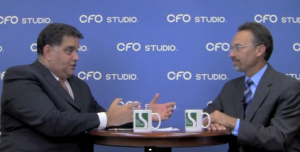As Seen in CFO Studio Magazine 2015 Q3 Issue and CFO Studio On-Camera Interview
Luke McKinnon has spent much of his career in the engineering industry, and since 2009 he has served as executive vice president and CFO of New York City–based consulting firm the Louis Berger Group, which provides architecture, construction management, and economic development services. Though his focus is on finances (previous roles include chief financial officer at AECOM and operations controller at URS, which are both in the same business areas as the Louis Berger Group), he approaches his work like an engineer, building or developing an accounting department to support the operational departments. Mr. McKinnon will be leading the CFO Studio Middle Market CFO Executive Dinner on “Preparing for Private Equity” on Sept. 10, but in the meantime, he sat down with Andrew Zezas, publisher of CFO Studio magazine and host of CFO Studio On-Camera, to discuss how aligning people, processes, and technology can yield broad benefits.
(ANDREW ZEZAS) You were brought in [to the Louis Berger Group] to kind of shake things up. How have you improved the accounting department of the company?
MCKINNON: When I got there, we were touching an invoice 15 times when it would come into Accounts Payable. Vendors would send me bills for every transaction. So we looked at technology where we could have our vendors submit electronically to us, in one bill at the end of the month. We went from approximately 5,000 invoices a month and nine people in the department, to 3,000 invoices a month and three people in the department. Vendors were no longer saying, “Did you get my invoice?” because they could see that they submitted it to us electronically, and it was going through the process.
Tell me about how these improvements benefited operations.
MCKINNON: I’ve got project managers that are sitting all around the world, so if they’ve got an employee that submits an expense report, before, it used to be in Excel format. We went to electronic software. Now, an employee can submit, and it goes to the project manager immediately. It was taking six to eight weeks to get an employee paid, [and now] if he submits his expense report on a Monday, the employee could have payment by Friday. You get an employee who no longer has to worry, “How am I going to pay my credit card?” The other benefit is, now, when those charges go onto a project billed to our client, the accuracy is not six months old, it’s from within the last week or two. They know it’s a timely bill.
In your whole career, you’ve been a guy who’s either been building accounting departments or rebuilding accounting departments. What’s the attraction to you there?
MCKINNON: I like the challenge. Whether it was fixing the AP department or a monthly close, or our timesheet process: You’re making sure it works for everybody, making it more efficient, making it more accurate. I find it exciting, I really do.




